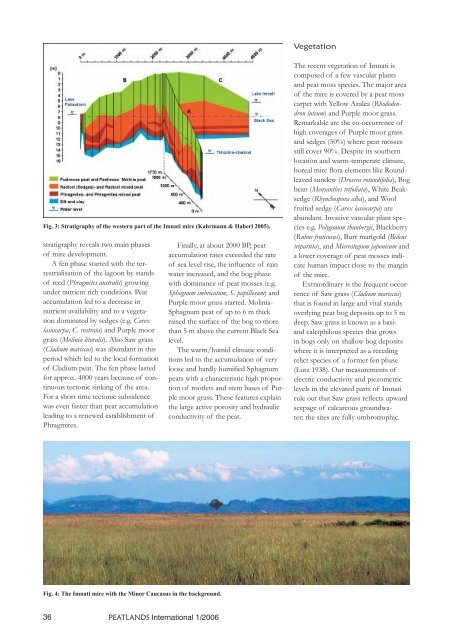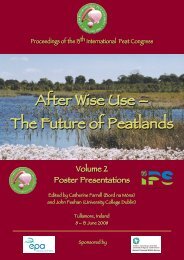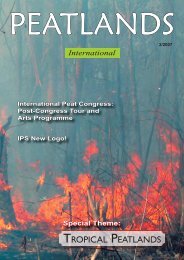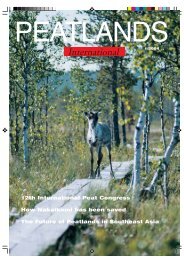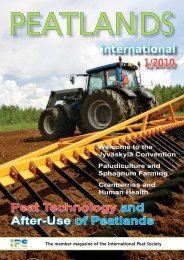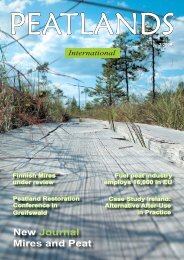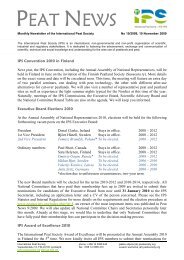peatlands 1 taitto.indd - International Peat Society
peatlands 1 taitto.indd - International Peat Society
peatlands 1 taitto.indd - International Peat Society
You also want an ePaper? Increase the reach of your titles
YUMPU automatically turns print PDFs into web optimized ePapers that Google loves.
Fig. 3: Stratigraphy of the western part of the Imnati mire (Kahrmann & Haberl 2005).<br />
stratigraphy reveals two main phases<br />
of mire development.<br />
A fen phase started with the terrestrialisation<br />
of the lagoon by stands<br />
of reed (Phragmites australis) growing<br />
under nutrient rich conditions. <strong>Peat</strong><br />
accumulation led to a decrease in<br />
nutrient availability and to a vegetation<br />
dominated by sedges (e.g. Carex<br />
lasiocarpa, C. rostrata) and Purple moor<br />
grass (Molinia litoralis). Also Saw grass<br />
(Cladium mariscus) was abundant in this<br />
period which led to the local formation<br />
of Cladium peat. The fen phase lasted<br />
for approx. 4000 years because of continuous<br />
tectonic sinking of the area.<br />
For a short time tectonic subsidence<br />
was even faster than peat accumulation<br />
leading to a renewed establishment of<br />
Phragmites.<br />
Fig. 4: The Imnati mire with the Minor Caucasus in the background.<br />
36 PEATLANDS <strong>International</strong> 1/2006<br />
Finally, at about 2000 BP, peat<br />
accumulation rates exceeded the rate<br />
of sea level rise, the infl uence of rain<br />
water increased, and the bog phase<br />
with dominance of peat mosses (e.g.<br />
Sphagnum imbricatum, S. papillosum) and<br />
Purple moor grass started. Molinia-<br />
Sphagnum peat of up to 6 m thick<br />
raised the surface of the bog to more<br />
than 5 m above the current Black Sea<br />
level.<br />
The warm/humid climatic conditions<br />
led to the accumulation of very<br />
loose and hardly humifi ed Sphagnum<br />
peats with a characteristic high proportion<br />
of rootlets and stem bases of Purple<br />
moor grass. These features explain<br />
the large active porosity and hydraulic<br />
conductivity of the peat.<br />
Vegetation<br />
The recent vegetation of Imnati is<br />
composed of a few vascular plants<br />
and peat moss species. The major area<br />
of the mire is covered by a peat moss<br />
carpet with Yellow Azalea (Rhododendron<br />
luteum) and Purple moor grass.<br />
Remarkable are the co-occurrence of<br />
high coverages of Purple moor grass<br />
and sedges (50%) where peat mosses<br />
still cover 90%. Despite its southern<br />
location and warm-temperate climate,<br />
boreal mire fl ora elements like Roundleaved<br />
sundew (Drosera rotundifolia), Bog<br />
bean (Menyanthes trifoliata), White Beaksedge<br />
(Rhynchospora alba), and Wool<br />
fruited sedge (Carex lasiocarpa) are<br />
abundant. Invasive vascular plant species<br />
e.g. Polygonum thunbergii, Blackberry<br />
(Rubus fruticosus), Burr marigold (Bidens<br />
tripartita), and Microstegium japonicum and<br />
a lower coverage of peat mosses indicate<br />
human impact close to the margin<br />
of the mire.<br />
Extraordinary is the frequent occurrence<br />
of Saw grass (Cladium mariscus)<br />
that is found in large and vital stands<br />
overlying peat bog deposits up to 5 m<br />
deep. Saw grass is known as a basi-<br />
and calciphilous species that grows<br />
in bogs only on shallow bog deposits<br />
where it is interpreted as a receding<br />
relict species of a former fen phase<br />
(Lutz 1938). Our measurements of<br />
electric conductivity and piezometric<br />
levels in the elevated parts of Imnati<br />
rule out that Saw grass refl ects upward<br />
seepage of calcareous groundwater:<br />
the sites are fully ombrotrophic.


